Global and China Automotive Wireless Communication Module Market Report, 2024
Communication module and 5G research: 5G module installation rate reaches new high, 5G-A promotes vehicle application acceleration
5G automotive communication market has exploded, and 5G FWA is evolving towards 5G-A
In 2023, 5G vehicle module installation ushered in a surge. According to statistics, China passenger car 5G module installation hits 1.633 million units in 2023, the installation rate is about 7.5%, and it is expected that the installation in 2027 will rise to 7.856 million with installation rate of 35.6%.

From the perspective of major models, the 5G installation rate of new energy models of emerging OEMs? is higher, such as Zeekr, Denza, Avatr, Voyah, IM, Li Auto and NIO, which have all achieved standard configuration of 5G module.
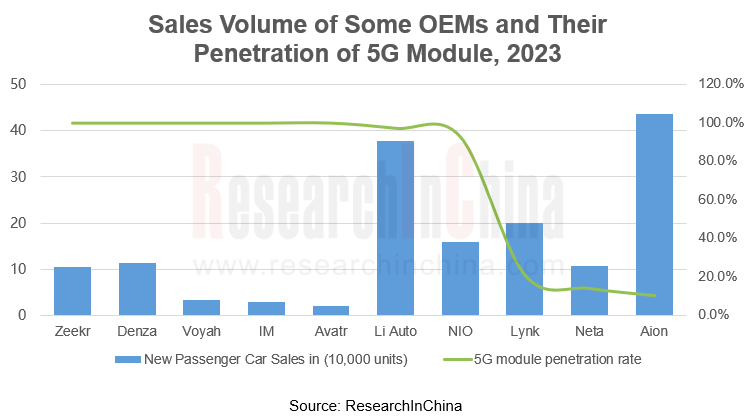
Factors driving 5G installation for OEMs
5G infrastructure is gradually improving: According to MIIT statistics, as of February 2024, the total number of 5G base stations in China reached 3.509 million, accounting for 29.8% of the total number of mobile base stations. And China is the country with the largest number of 5G base stations in the world, accounting for more than 65%;
5G policy standards are gradually improved: In August 2023, Shanghai Mobile and China Academy of Information and Communications Technology took the lead in organizing more than 20 standard drafting units to participate in preparation of "5G Network Planning, Construction and Acceptance Requirements for Supporting High-level Autonomous Driving" and "5G Network Performance Requirements for Supporting High-level Autonomous Driving" and other two group standards were officially released and implemented, filling the gap of corresponding standards at home and abroad; in December 2023, Huawei and China Mobile, Unicom, Quectel, Fuzhou Internet of Things Open Laboratory, Fudan University School of Microelectronics, etc. jointly developed and released 5G automotive-grade module Uu port communication certification standard 1.0;
5G is more suitable for development of autonomous driving: The development of autonomous driving requires high speed and low latency, which is difficult to meet with 4G modules. The three major characteristics of 5G network are fast transmission speed, low latency, and D2D device transmission technology, which realizes ultra-low latency of 1 ms, high peak rate of 20 Gbps, and extremely high density of up to 1,000,000 vehicles and devices, making it ideal for the development of autonomous driving.
5G is evolving towards 5G-A: 2024 is the first year of 5G-A. The new capabilities brought by 5G-A can effectively meet applications such as in-vehicle software OTA, in-car large-screen entertainment and smart driving training, and 5G-A can be combined with AI to better meet the network needs of AI era. At present, Beijing, Shanghai, Hangzhou and other places have landed 5G-A-based telematics demonstration lines.
In March 2024, Shanghai Mobile and Huawei completed the construction of the first smart parking underground parking network in Shanghai Pudong, providing 5G-A network coverage for more than 70,000 square meters of underground space. The 5G-A parking lot can provide an uplink capacity of over 500Mbps, claiming to be able to meet parking and driving functions of hundreds of cars at the same time; the 5G-A network can also achieve a downlink super gigabit rate, and the vehicle OTA version upgrade can be completed in as little as 30 seconds.
In comparison, the traditional 4G FWA average rate is about 20Mbps, and the 5G FWA average rate is about 100Mbps. 5G-A network will bring a better user experience and promote the acceleration of 5G modules.
In satellite broadband technology, MediaTek showcased a new generation of 5G-Advanced satellite test chips at MWC2024, which can provide more than 100Mbps of data throughput for automobiles and a variety of other termnal devices.
5G-Advanced (5G-A) standards are frozen, and the tide of commercialization is launched
R18 is the first 5G-A version. In February 2024, Huawei promoted 3GPP R18 standard base station energy-saving core part to reach an agreement and freeze at the 102nd meeting of RAN. The freezing of this part marks the concept of "0 Bit 0 Watt" and "Double Excellence of Experience and Energy Saving" advocated by Huawei, was officially accepted by 3GPP International Standards Organization. On June 18, 2024, 3GPP Release 18 was officially frozen, meeting the conditions for commercialization.
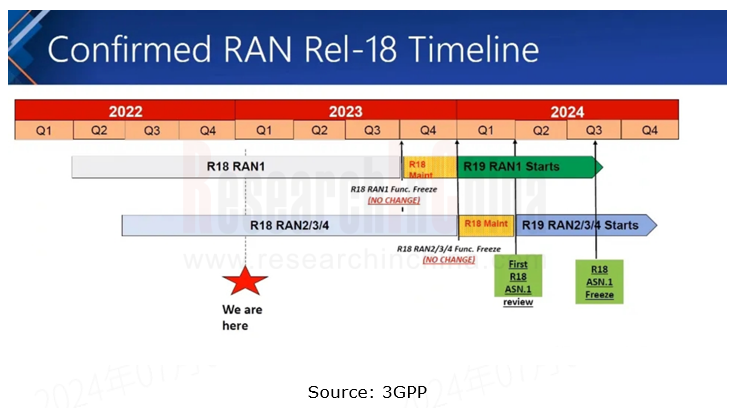
The milestone of 6G standardization process has arrived
In December 2023, 3GPP held RAN #102 meeting and identified the first batch of 16 RAN projects in the Rel-19 field, marking a new stage in the development of 5G-Advanced international standards. Looking to the future, 3GPP's 6G work began in 2024 during Release 19, which marked the official start of work related to "requirements" (i.e. 6G SA1 business requirements). This is an important milestone in the 6G standardization process and lays the foundation for subsequent work.
In addition, 3GPP expects the first 6G specification to be completed in Release 21 by the end of 2028. This means that in about four years, 3GPP will complete the core specification of 6G, paving the way for commercialization of 6G technology.
5G module development platform: Qualcomm dominates, and domestic platforms such as ZTE, Huawei, and MediaTek are developing rapidly
Mainstream 5G module development platforms include ZTE, Huawei, Qualcomm, MediaTek, etc. Module supplierrs such as Quectel, Fibocom, MeiG Smart Technology, ZTE Communication, Huawei, and LG provide 5G module products for OEMs based on the development platform.
ZTE 5G Development Platform
5G module ZM9300: Using 3GPP Rel-16 technology, based on self-developed car-grade 5G Modem chip platform, supports optional configuration R16 NR & LTE-V2X PC5 direct communication; built-in computing power exceeds 18K + DMIPS CPU, which can support C-V2X ITS protocol stack and applications, without external AP processor. The ZM9300 module will be mass-produced and loaded on GAC in 2024.
4G module ZM8201V: equipped with a self-developed 4G communication chip platform. It has been first mass-produced and delivered in SAIC MAXUS Xintu V80, and subsequent SAIC passenger cars will also be equipped with this module product one after another. At the same time,? ZM8201V has passed AEC Q100 vehicle certification, supports overseas eCa11, and has passed network access certification test of operators in more than 70 countries around the world.
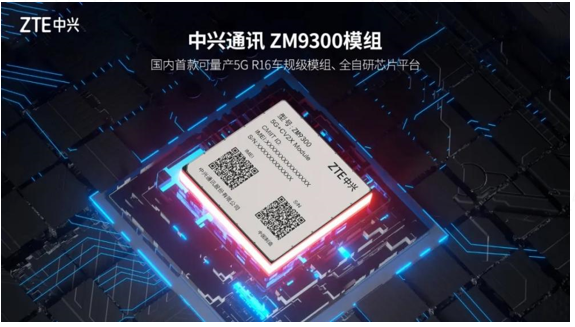
MediaTek 5G Development Platform
MediaTek MTK2735: In China, products such as Fibocom AN758 and Mobiletek?Communication T800 are equipped with MediaTek MTK2735. Mobiletek?Communication T800 is the first MTK 5G module in China to obtain European Union ecall certification and Huawei compatibility test certification. As early as 2022, MediaTek's automotive 5G modems have entered the supply chain of Japanese and European OEMs.
MediaTek Dimensity Auto 5G smart cockpit platform: includes four SoC products, CX-1, CY-1, CM-1 and CV-1, using 3nm/4nm advanced manufacturing process. The communication technologies supported by Dimensity Auto include: 5G Sub-6GHz carrier aggregation technology, Wi-Fi 7, GNSS, 5G NTN two-way satellite communication capability, V2X vehicle connection communication, etc.
Qualcomm 5G Development Platform
Qualcomm's 5G platform has evolved to the latest generation of SA525M/SM522M platforms, and for the latest generation of 5G platforms launched by Qualcomm, module suppliers such as Quectel, Fibocom, and MeiG Smart Technology have also made arrangements.?
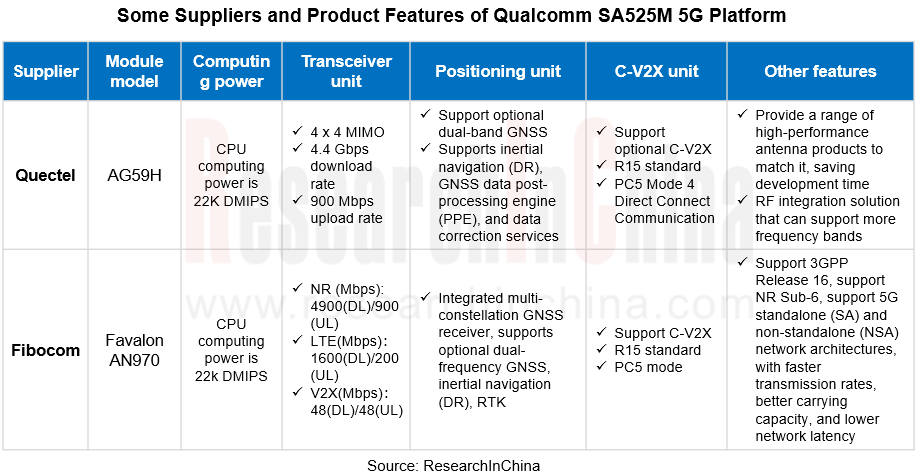
Quectel AG59 series: including AG59xH series based on Qualcomm SA525M platform and AG59xE series based on Qualcomm SA522M platform. At the same time, Quectel also provides a series of high-performance antenna products to match the modules of this series, which can shorten R & D cycle of customer products. Quectel's modules have been mass-produced in nearly 20 mainstream OEMs such as SAIC, Great Wall, FAW Hongqi, NIO, and Li Auto.
Fibocom AN970T: AN970 series based on Qualcomm SA525M and AN960 series based on SA522M, two series of modules P2P, support customers to switch quickly.
Among them, the AN970 series module has a CPU computing power of up to 22k DMIPS, integrates multi-constellation GNSS receivers, supports optional dual-frequency GNSS, inertial navigation (DR), RTK, C-V2X units, 3GPP Release 16, NR Sub-6, 5G independent networking (SA) and non-independent networking (NSA) architectures, with faster transmission rates, better carrying capacity, and lower network latency.
Innovative in-vehicle communication module products emerge in an endless stream, bringing a diverse experience
1) Intelligent modules: communication modules are moving towards a high degree of integration with cockpit
In the development environment of automotive domain control architecture, automotive wireless communication solutions have entered a stage of cost-effectiveness improvement, driving vehicle modules to evolve towards integrated intelligent modules. Compared with traditional communication modules, intelligent modules will further integrate operating systems, CPUs/GPUs, etc.
The current intelligent modules on the market are mainly developed based on Qualcomm platform. The newly released MediaTek Dimensity Auto 5G smart cockpit platform has received great attention from the market and will help MediaTek achieve high-end market breakthroughs.
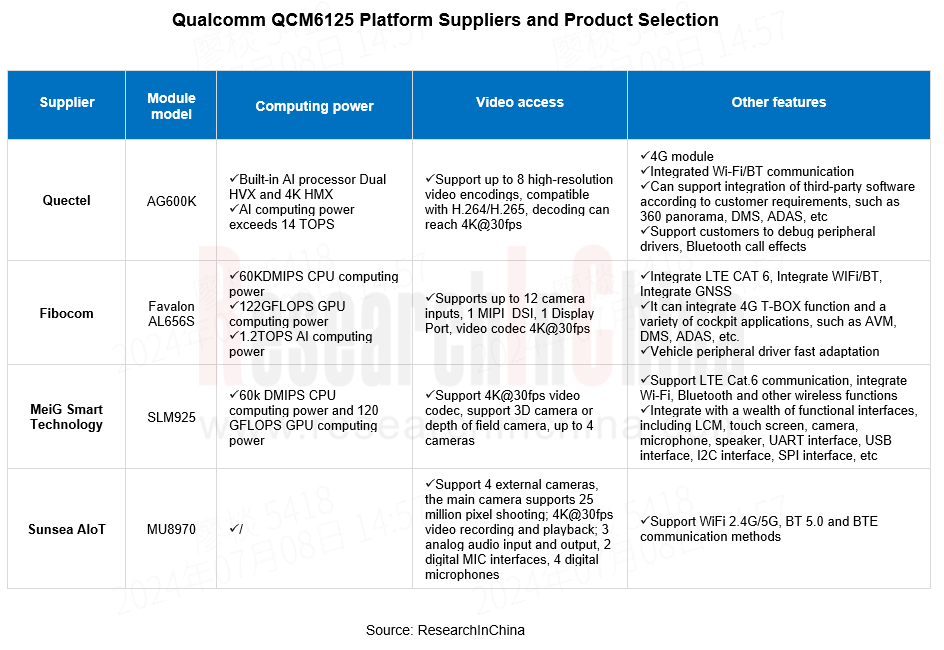
MeiG Smart Technology: Intelligent module SLM925 supports LTE Cat.6 communication, integrates Wi-Fi, Bluetooth, GNSS and other wireless functions, supports Android 10 operating system, supports 4K@30fps video codec, supports 3D camera or depth of field photography, supports dual-screen display, can support 8-way camera, supports 8-channel TDM, meets the requirements of vehicle temperature and width, and has obtained designation from a number of OEMs.
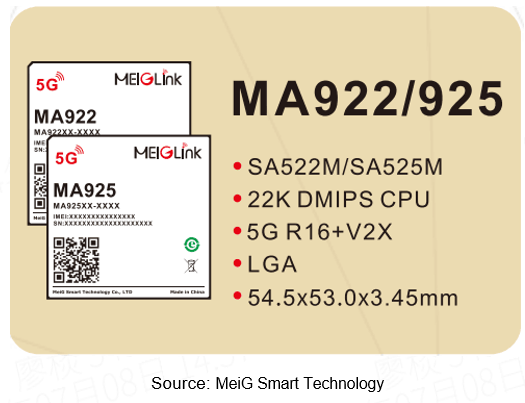
2) NearFlash module
NearFlash technology, as a new generation of wireless short-range communication technology, is applied in smart cars including digital car keys, head unit projection, intelligent terminal display, and wireless audio & video application solutions around the smart cockpit.
At present, based on NearFlash technology, Huawei, PATEO, Lilda, etc. have launched vehicle products.
PATEO: In April 2024, the demo product showing NearFlash smart key has characteristics of sensing the owner within 80 meters, automatically opening the lights and reflectors in 9-meter welcome area, and unlocking the vehicle within 3 meters.
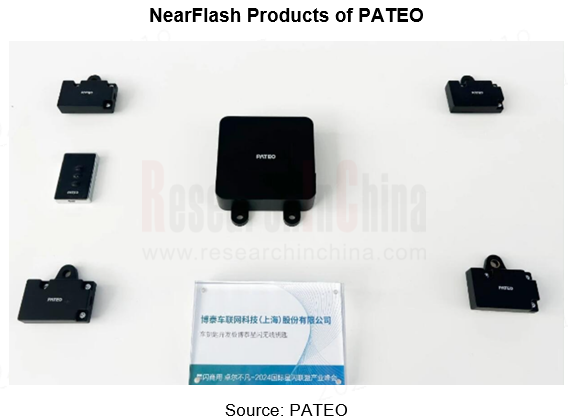
3)WIFI7 Module
As the WiFi 7 standard continues to improve, chip vendors and module suppliers have deployed WiFi 7 technology, and the world's first automotive Wi-Fi 7 solution was launched by Qualcomm in early 2024, namely Qualcomm QCA6797AQ.
Qualcomm QCA6797AQ supports 320MHz channel bandwidth, 4K QAM technology enables peak throughput up to 5.8Gbps, and also introduces innovative technologies such as high-frequency concurrency and multi-link multi-radio frequency.

Global and China Automotive Wireless Communication Module Market Report, 2024 includes following contents:
 Research on development policies, industry standards, market size, competition landscape, etc. of automotive wireless communication module industry;
Research on development policies, industry standards, market size, competition landscape, etc. of automotive wireless communication module industry;
 Application of automotive 5G modules, including 5G platform selection, 5G loading applications, 5G standard vehicles, 5G technology trends, etc.
Application of automotive 5G modules, including 5G platform selection, 5G loading applications, 5G standard vehicles, 5G technology trends, etc.
 The application prospect of automotive intelligent modules, including research on development platform selection, production process, development status and trends, etc.
The application prospect of automotive intelligent modules, including research on development platform selection, production process, development status and trends, etc.
 Research on the latest developments and manufacturer layouts of innovative modules, such as NearFlash modules, WiFi 7 modules, C-V2X modules, etc.;
Research on the latest developments and manufacturer layouts of innovative modules, such as NearFlash modules, WiFi 7 modules, C-V2X modules, etc.;
 Research on the product lines of major suppliers of automotive communication chips and communication modules, technology trends, and vehicle loading and mass production trends.
Research on the product lines of major suppliers of automotive communication chips and communication modules, technology trends, and vehicle loading and mass production trends.
Autonomous Driving Domain Controller and Central Computing Unit (CCU) Industry Report, 2025
Research on Autonomous Driving Domain Controllers: Monthly Penetration Rate Exceeded 30% for the First Time, and 700T+ Ultrahigh-compute Domain Controller Products Are Rapidly Installed in Vehicles
L...
China Automotive Lighting and Ambient Lighting System Research Report, 2025
Automotive Lighting System Research: In 2025H1, Autonomous Driving System (ADS) Marker Lamps Saw an 11-Fold Year-on-Year Growth and the Installation Rate of Automotive LED Lighting Approached 90...
Ecological Domain and Automotive Hardware Expansion Research Report, 2025
ResearchInChina has released the Ecological Domain and Automotive Hardware Expansion Research Report, 2025, which delves into the application of various automotive extended hardware, supplier ecologic...
Automotive Seating Innovation Technology Trend Research Report, 2025
Automotive Seating Research: With Popularization of Comfort Functions, How to Properly "Stack Functions" for Seating?
This report studies the status quo of seating technologies and functions in aspe...
Research Report on Chinese Suppliers’ Overseas Layout of Intelligent Driving, 2025
Research on Overseas Layout of Intelligent Driving: There Are Multiple Challenges in Overseas Layout, and Light-Asset Cooperation with Foreign Suppliers Emerges as the Optimal Solution at Present
20...
High-Voltage Power Supply in New Energy Vehicle (BMS, BDU, Relay, Integrated Battery Box) Research Report, 2025
The high-voltage power supply system is a core component of new energy vehicles. The battery pack serves as the central energy source, with the capacity of power battery affecting the vehicle's range,...
Automotive Radio Frequency System-on-Chip (RF SoC) and Module Research Report, 2025
Automotive RF SoC Research: The Pace of Introducing "Nerve Endings" such as UWB, NTN Satellite Communication, NearLink, and WIFI into Intelligent Vehicles Quickens
RF SoC (Radio Frequency Syst...
Automotive Power Management ICs and Signal Chain Chips Industry Research Report, 2025
Analog chips are used to process continuous analog signals from the natural world, such as light, sound, electricity/magnetism, position/speed/acceleration, and temperature. They are mainly composed o...
Global and China Electronic Rearview Mirror Industry Report, 2025
Based on the installation location, electronic rearview mirrors can be divided into electronic interior rearview mirrors (i.e., streaming media rearview mirrors) and electronic exterior rearview mirro...
Intelligent Cockpit Tier 1 Supplier Research Report, 2025 (Chinese Companies)
Intelligent Cockpit Tier1 Suppliers Research: Emerging AI Cockpit Products Fuel Layout of Full-Scenario Cockpit Ecosystem
This report mainly analyzes the current layout, innovative products, and deve...
Next-generation Central and Zonal Communication Network Topology and Chip Industry Research Report, 2025
The automotive E/E architecture is evolving towards a "central computing + zonal control" architecture, where the central computing platform is responsible for high-computing-power tasks, and zonal co...
Vehicle-road-cloud Integration and C-V2X Industry Research Report, 2025
Vehicle-side C-V2X Application Scenarios: Transition from R16 to R17, Providing a Communication Base for High-level Autonomous Driving, with the C-V2X On-board Explosion Period Approaching
In 2024, t...
Intelligent Cockpit Patent Analysis Report, 2025
Patent Trend: Three Major Directions of Intelligent Cockpits in 2025
This report explores the development trends of cutting-edge intelligent cockpits from the perspective of patents. The research sco...
Smart Car Information Security (Cybersecurity and Data Security) Research Report, 2025
Research on Automotive Information Security: AI Fusion Intelligent Protection and Ecological Collaboration Ensure Cybersecurity and Data Security
At present, what are the security risks faced by inte...
New Energy Vehicle 800-1000V High-Voltage Architecture and Supply Chain Research Report, 2025
Research on 800-1000V Architecture: to be installed in over 7 million vehicles in 2030, marking the arrival of the era of full-domain high voltage and megawatt supercharging.
In 2025, the 800-1000V h...
Foreign Tier 1 ADAS Suppliers Industry Research Report 2025
Research on Overseas Tier 1 ADAS Suppliers: Three Paths for Foreign Enterprises to Transfer to NOA
Foreign Tier 1 ADAS suppliers are obviously lagging behind in the field of NOA.
In 2024, Aptiv (2.6...
VLA Large Model Applications in Automotive and Robotics Research Report, 2025
ResearchInChina releases "VLA Large Model Applications in Automotive and Robotics Research Report, 2025": The report summarizes and analyzes the technical origin, development stages, application cases...
OEMs’ Next-generation In-vehicle Infotainment (IVI) System Trends Report, 2025
ResearchInChina releases the "OEMs’ Next-generation In-vehicle Infotainment (IVI) System Trends Report, 2025", which sorts out iterative development context of mainstream automakers in terms of infota...